Plus Two Zoology Chapter Wise Questions and Answers Chapter 6 Human Health and Disease are part of Plus Two Zoology Chapter Wise Questions and Answers. Here we have given Plus Two Zoology Chapter Wise Questions and Answers Chapter 6 Human Health and Disease.
| Board | SCERT, Kerala |
| Text Book | NCERT Based |
| Class | Plus Two |
| Subject | Zoology Chapter Wise Questions |
| Chapter | Chapter 6 |
| Chapter Name | Human Health and Disease |
| Number of Questions Solved | 89 |
| Category | Kerala Plus Two |
Kerala Plus Two Zoology Chapter Wise Questions and Answers Chapter 6 Human Health and Disease
Plus Two Zoology Human Health and Disease One Mark Questions and Answers
Question 1.
The immunoglobulin present in mother’s milk is
(a) lgD
(b) lgE
(c) 1gM
(d) lgA
Answer:
(d) lgA
Question 2.
Short-lived immunity acquired from mother to foetus across placenta or through mother’s milk to the infant is categorized as
(a) active immunity
(b) passive immunity
(c) cellular immunity
(d) innate or non-specific immunity
Answer:
(b) passive immunity
Question 3.
Malarial parasite is introduced into the blood of man as a
(a) meta crypto zoite
(b) schizont
(c) oocyte
(d) sporozoite
Answer:
(d) sporozoite
Question 4.
The genes concerned with the production of cancer are called
(a) cancer genes
(b) carcino genes
(c) carcinomas
(d) oncogenes
Answer:
(c) carcinomas
Question 5.
A drug called morphine is obtained from
(a) Rauwoiffia serpentina
(b) Cannabis sativa
(c) Cajanuscajan
(d) Papaversomniferum
Answer:
(d) Papaversomniferum
Question 6.
Observe the relationship between the first two words and fill in the blanks.
- Ascariasis: Ascaris, Elephantiasis:-
- Cannabinoids: Hashish, Opioids:-
Answer:
- Wuchereria
- Heroin
Question 7.
Choose the odd one with reason. Malaria, Pneumonia, Cancer, Hyphoid.
Answer:
Cancer.
All others are infectious diseases.
Question 8.
“Death rate due to Cancer is high now a days” Name the gene casing cancer.
Answer:
Oncogene
Question 9.
One your classmate is suspected to be having typhoid and you advise him to consult a doctor and to do the confirmation test. Name the medical confirmation test.
Answer:
Widal test
Question 10.
Amoeboid dysentery is caused by a protozoan parasite. Name the parasite.
Answer:
Entamoeba histolytica
Question 11.
Identify the odd one
(a) Malaria
(b) Elephantiasis
(c) Typhoid
(d) Dengue
Answer:
(c) Typhoid; all others are vector bone disease
Question 12.
WBC, PMNL monocytes and natural killer cells are then examples of
(a) Physical Barriers
(b) Physiological barrier
(c) Cellular barrier
(d) Cytokine barriers
Answer:
(c) Cellular barrier
Question 13.
When the immune system attacks our own cells, the process is called……….
(a) Innate immunity
(b) Acquired immunity
(c) Auto immunity
(d) Humoral immunity
Answer:
(c) Auto immunity
Question 14.
AIDS is caused by HIV. Which type of virus is HIV?
(a) Adenovirus
(b) Retrovirus
(c) Bacteriophage
(d) Rhinovirus
Answer:
(b) Retrovirus
Question 15.
Mother’s colostrum contains Ig G. What type of immunity it confers to the infants?
(a) Passive immunity
(b) Active immunity
(c) Cell mediate immunity
(d) Innate immunity
Answer:
(a) Passive immunity
Plus Two Zoology Human Health and Disease Two Mark Questions and Answers
Question 1.
Malaria is a disease, man has been fighting since many years.
- Name the protozoan which cause Malaria and the toxic substance released by it.
- Which part of the body is mainly affected by the parasite?
Answer:
- Plasmodium (P.Vivax, P.Malaria, P.Falciparum) Haemozoin
- The parasite initially multiply within liver cells and then attack RBC, resulting in their rupture, which causes the release of haemozoin.
Question 2.
Cancer can be cured completely. Write down two diagnostic and treatment methods.
Answer:
1. Diagnostic methods:
- Biopsy
- CT Scan
- MRI etc.
2. Treatments:
- Surgery
- Radiation therapy
- Immunotherapy etc.
Question 3.
Select the odd one from the given groups and assign reason.
- Gonorrhea, Typhoid, Syphilis, Chlamydiasis
- Spleen, Tonsil, Lymph nodes, Thymus
Answer:
- Typhoid. All others are sexually transmitted diseases.
- Thymus. All others are secondary lymphoid organs.
Question 4.
Fill in the blanks in the different columns of the table given below.
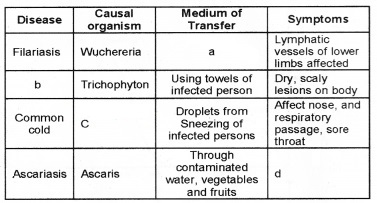
Answer:
- Insect bite
- Ringworm
- Rhinovirus
- Internal bleeding, fever, muscle pain
Question 5.
Maintenance of Personal and Public hygiene is very important for prevention and control of many infectious diseases. Justify this statement.
Answer:
Infectious diseases are spread mainly through air, food, drinking water, vectors, etc. Personal and public hygiene help to prevent infectious diseases.
Not only that balanced diet, regular exercise, vaccination, proper waste disposal, control of vectors, etc. are also necessary to prevent diseases and for achieving good health.
Question 6.
Complete the table.

Answer:
- ELISA
- Typhoid
Question 7.
“The soldiers of a country kills their own king”. Keeping this mind, in our body can you find a similar situation in some person. Give examples.
Answer:
Auto immune response
Eg: Rhuematoid arthritis, Myasthenia gravis.
Question 8.
During a discussion, your friend said that “AIDS can also be transmitted through food and touch.”
- How HIV infects human body?
- What clinical test is used to confirm AIDS?
Answer:
- Method of infection is through body fluids, sexual contact, contaminated needles, blood transfusion from mother to foetus,
- Western blot/ELISA
Question 9.
You are working as a volunteer in an AIDS awareness programme. If a person comes to you and asks the following questions, how will you answer?
- How HIV multiplies in host cell?
- What are the precautions to be taken to prevent AIDS?
Answer:
1. HIV, being a retrovirus, enters the macrophages, where the RNA replicates to form viral DNA. It incorporated into the host cell’s DNA and directs infected cells to produce viral particle.
2. Avoid unsafe sex with a stranger.
- Use of disinfected needles.
- Avoid sharing of injection needles.
- Screening of blood before transfusion.
Question 10.
A sportsperson was tested positive for cannabinoid. What are these? From where are these extracted?
Answer:
Cannabinoids are group of chemicals interact with cannabinoid receptors in the brain. Cannabis sativa.
Question 11.
More than a million Indians suffer from cancer and a large number of them die from it annually. Unlike normal cells, cancer cells possess some unique features. List any two of them.
Answer:
- Loss of contact inhibition
- Metastasis
Question 12.
“Prevention is better than cure”. Can you suggest some important preventive measures of STD’s.
Answer:
- Avoid sex with a stranger/multiple partner.
- Always use condoms during coitus.
Question 13.
Give the scientific term for the following.
- Spreading of cancer cell into distant place.
- Hypersensitivity to certain substance
Answer:
- Metastasis
- Allergy
Question 14.
A group of five members spent in a room with dust. One among them shows some allergic responses.
- Name the chemicals released during allergy and which cells produce them.
- Which are the drugs used to reduce the symptoms quickly?
Answer:
- Histamine and serotonine from mast cells,
- Anti-histamine drugs, adrenalin, and steroids.
Question 15.
What is the role of histamine in inflammatory response? Name few drugs which reduce the symptoms of allergy.
Answer:
- The histamine acts as allergy mediator which cause blood vessels to dilate. It is released by mast cells.
- Antihistamine, steroids, and adrenaline quickly reduce the symptoms of allergy.
Question 16.
Name one plant and the additive drug extracted from latex. How does this drug affect the human body?
Answer:
Papaver somniferum (Poppy plant)
- Morphine is obtained from this plant.
- It is an opioid that binds to specific receptors in the central nervous system and gastro intestinal tract; it slows down the body functions.
Question 17.
How does the transmission of each of the following diseases take place?
- Amoebiasis
- Malaria
- Ascariasis
Answer:
1. Amoebiasis, By ingesting quadrinucleated cysts of Entamoeba histolytica with food and water. The cysts are carried from faces of patient to food and water.
2. Malaria. Plasmodium (malarial parasite) is trans-mitted from sufferer to healthy one by biting of female Anopheles mosquito.
3. Ascariasis. The disease is transmitted by taking contaminated food and water with embryonated egg of Ascaris.
Question 18.
Match the following.
| Pathogen | Symptoms | Effector |
| a. Salmonella Typhi | Stool with excess blood | Alveoli |
| b. Plasmodium | Sustained high fever | Large Intestine |
| c. Strep to cocus pneumonia | High fever recurring every three days | Enter small intestine |
| d. Entamoeba | Fever, Chills | RBC |
Answer:
| Pathogen | Symptoms | Effector |
| a. Salmonella Typhi | Sustained high fever | Enter small intestine |
| b. Plasmodium | High fever recurring every three days | RBC |
| c. Strep to cocus pneumonia | Fever, Chills | Alveoli |
| d. Entamoeba | Stool with excess blood | Large Intestine |
Question 19.
The graph given below shows the response of attack of an influenza virus in a patient repeatedly during the interval of 40 days.
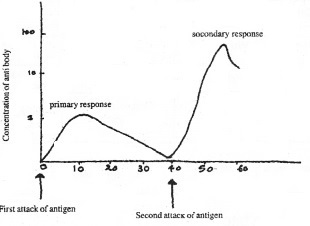
- What is the difference in the response during the first and second attacks?
- Give the reason for this change.
Answer:
- In secondary response, more antibody is produced than primary response.
- In secondary response, the memory cells help to produce more antibody rapidly than the primary response.
Question 20.
Elaborate the diagnostic methods used for early detection of cancer.
Answer:
X ray, CT Scan, and MRI Scan, Specific antibody against cancer cell, identification of cancer genes.
Question 21.
You meet an HIV patient. He is unaware about the transmission method of HIV. What precautions will you suggest him so that HIV cannot be spread to others?
Answer:
Use disposable needles, use of condoms, safe blood transfusion, safe sex, controlling drug use.
Question 22.
Write the difference between malignant tumor and benign tumor?
Answer:
1. Benign tumors: normally confined to their original location and do not spread to the other parts of the body.
2. Malignant tumors: it is the mass of proliferating cells invading and damaging surrounding normal cells quickly dividing and have property called metastasis.
Question 23.
Briefly explain the methods used to treat cancer.
Answer:
Surgery, radiation therapy, chemotherapy, immunotherapy.
Plus Two Zoology Human Health and Disease Three Mark Questions and Answers
Question 1.
Name the type of immunity that is present at the time of birth in humans. Explain any two ways by which it is accomplished.
Answer:
Innate immunity is present at the time of birth. This is accomplished by providing different types of barriers to the entry of the foreign agents into our body. It consists of four type of barriers:
- Physical barrier- Skin and mucus
- Physiological barrier- Acid in the stomach, saliva in the mouth and tears.
- Cellular barrier- Neutrophils and macrophages.
- Cytokine barrier-Interferons.
Question 2.
Match the following.
| Disease | Pathogen |
| a. Malaria | Epidermophyton |
| b. Filariasis | Ascaris |
| c. Amoebiasis | HIV |
| d. AIDS | Entamoeba histolytica |
| e. Ringworm | Plasmodium |
| f. Ascariasis | Wuchereria |
Answer:
| Disease | Pathogen |
| a. Malaria | Plasmodium |
| b. Filariasis | Wuchereria |
| c. Amoebiasis | Entamoeba histolytica |
| d. AIDS | HIV |
| e. Ringworm | Epidermophyton |
| f. Ascariasis | Ascaris |
Question 3.
A person injured in a road accident and requiring an urgent immune response was brought to a doctor.
- What did the doctor immediately do?
- What kind of immunity was he providing to the patient?
- Define this kind of immunity.
Answer:
- Performed antibodies are injected
- Passive immunity
- Passive immunity is developed by injecting the performed antibodies, which neutralize the antigen.
Question 4.
Fill in the blanks.
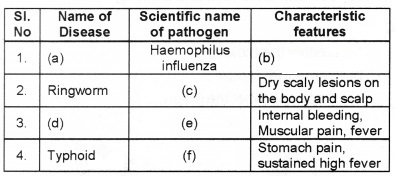
Answer:
- a – Pneumonia
- b – Fever, chills, cough, and headache
- c – Microsporum
- d – Ascariasis
- e – Ascaris lubricoids
- f – Salmonella typhi
Question 5.
Lymphoid organs play an important role in immunity, where maturation and proliferation of lymphocyte takes place.
- What are the primary lymphoid organs?
- Name the lymphoid tissue located within the lining of major tracts.
- What are the secondary lymphoid organs, which provide sites for interaction of lymphocytes with the antigen.
Answer:
- Bone marrow and Thymus
- MALT (Mucosal Associated Lymphoid Tissue)
- Spleen, Lymph nodes, Tonsils, Peyer’s patches
Question 6.
Write the single word for the following.
- Glycoproteins secreted by virus-infected cells.
- Antibody-dependent immunity.
- The type of antibody produced during allergy.
Answer:
- Interferons
- Humoral immunity
- lgE
Question 7.
A patient consult a doctor with the following symptoms.
- Constipation
- Abdominal pain and cramps
- Stools with excess mucous and blood clots.
- Identify the disease.
- Name the microbe that causes this disease.
- Write the mode of transmission of this disease.
Answer:
- Amoebic dysentery
- Entamoeba hystolytica
- Contaminated food and drinking water
Question 8.
- Identify the molecule.
- Name the types.
- Copy and label the diagram.
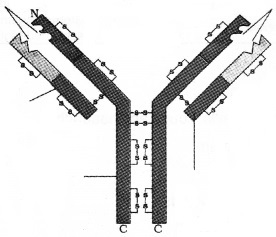
Answer:
- Immunoglobin
- lgA, lgM, lgE, lgG

Question 9.
A doctor noticed a small internal growth in the abdomen of a patient. Doctor suspects it as cancer.
- Name any two possible Carcinogens.
- Which biomedical technique is used for the diagnosis of cancer.
- Suggest the methods to treat this disease.
Answer:
1. Ionising radiation (X-ray, gamma-ray)
- Oncogenic viruses
- Chemicals like nicotine, polycyclic hydrocarbons, etc.
2. Biopsy/Scanning/MRI/Sonography etc.
3. Chemotherapy, Surgery, Hormone therapy, Radiation therapy, and Immune therapy.
Question 10.
Complete the table.
| Disease | Causative organism |
| Typhoid | |
| Common cold | |
| Plasmodium | |
| Ascaris |
Answer:
| Disease | Causative organism |
| Typhoid | Salmonella typhi |
| Common cold | Rhino virus |
| Malaria | Plasmodium |
| Ascariasis | Ascaris |
Question 11.
Identify the disease from the symptoms given below table.
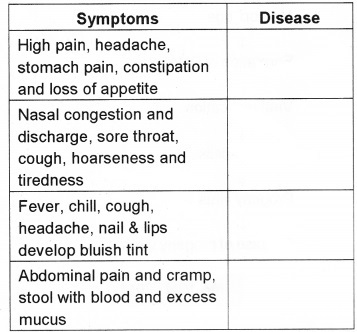
Answer:

Question 12.
Complete the table

Answer:

Question 13.
A doctor noticed a small internal growth in the abdomen of a patient. Doctor suspects it as cancer.
- Name any two possible Carcinogens.
- Which biomedical technique is used for the diagnosis of cancer.
- Suggest the methods to treat this disease.
Answer:
1. Ionising radiation (X-ray, gamma-ray)
- Oncogenic viruses
- Chemicals like nicotine, polycyclic hydrocarbons, etc.
2. Biopsy/Scanning/MRI/Sonography etc.
3. Chemotherapy, Surgery, Hormone therapy, Radiation therapy, and Immune therapy.
Question 14.
The symptoms of some diseases are given below. Identify the disease, name the parasite which cause the disease and write the mode of transmission.
- Weakness, Stomach pain, sustained high fever, constipation, etc.
- Fever, chill, cough, headache, bluish fingernails, etc.
- Constipation, abdominal pain, cramps, stools with mucus and blood, etc.
- Dry, scaly lesions on skin, nails, and scalp, itching, etc.
Answer:
1.
- Typhoid
- Salmonella typhi
- Contaminated food and water
2.
- Pneumonia
- Streptococcus pneumoniae
- Droplet infection/ sharing glasses and utensils etc.
3.
- Amoebic dysentery (Amoebiasis)
- Entamoeba histolytica
- Contaminated food and drinking water
4.
- Ringworms
- Fungi (Microsporum/Trichophyton Epidermophyton)
- Soil and towels, clothes, or comb of infected persons
Plus Two Zoology Human Health and Disease NCERT Questions and Answers
Question 1.
What measures would you take to prevent water-borne diseases?
Answer:
- Drinking clean water.
- Periodic cleaning and disinfection of water tanks and reservoirs.
Question 2.
Discuss with your teacher what does suitable gene means, in the context of DNA vaccines.
Answer:
The term Suitable Gene refers to that specific segment of DNA that will be modified in the host to produce protein to kill specific disease-causing organisms.
Question 3.
Name the primary and secondary lympboid organs.
Answer:
1. Primary Lymphoid organs: Bone marrow and thymus.
2. Secondary Lymphoid organs: Spleen, lymph nodes, Peyer’s patches (small intestine) and mucosal associated lymphoid tissues (MALT).
Question 4.
Expand the following terms:
- MALT
- CM I
- AIDS
- NACO
- HIV
Answer:
- MALT:- Mucosal – Associated Lymphoid Tissue
- CMI – Cell Mediated Immunity
- AIDS -Acquired Immuno Deficiency Syndrome
- NACO – National AIDS Control Organisation
- HIV – Human Immuno Deficiency Virus.
Question 5.
Differentiate the following and give example of each:
- Innate and acquired immunity
- Active and passive immunity
Answer:
| Innate Immunity | Acquired Immunity |
| Non – specific | Specific |
| Is present from birth | Is acquired in response to a specific pathogen |
| Involves different types of barriers | Involves memory of antibody |
| Example: Skin acts like a barrier | Example: Antibody response after vaccination. |
Question 6.
What are the various public health measures, which you would suggest to safeguard us against infectious diseases?
Answer:
- Proper disposal of wastes and excreta
- Periodic cleaning and disinfection of water sources.
- Observing standard practices of hygiene in public catering.
- Avoiding close and prolonged contact with infected persons suffering from contagious diseases.
- Eliminating the breeding places of the vectors of infectious diseases like malaria.
Question 7.
What are the various routes by which transmission of human immunodeficiency virus takes place?
Answer:
Various modes of transmission of HIV are sexual intercourse; use of contaminated hypodermic needles and syringes; blood transfusion organ transplantation; artificial insemination; from infected mother to baby during parthurition (30%) and breast feeding.
Question 8.
What is the mechanism by which the AIDS virus causes deficiency of immune system of the infected person?
Answer:
HIV attacks the helper-T cells inside the host cell, viral RNA syntheses single-stranded DNA on it in the presence of enzyme reverse transcriptase. Single-stranded DNA separates from viral RNA and forms its complimentary copy to form double-stranded DNA which is incorporated into hosts cell DNA.
The viral DNA transcribes large number of RNA particles, each of which gets surrounded by a proteinous capsid to complete viral particles.
Finally, the host helper T- cell is lysed and many HIV viruses are released. Each of these infects new Helper T-cells. So there is progressive decrease in the number of Helper-T- cells.
Question 9.
Do you think that friends can influence one to take alcohol/drugs? If yes, how may one protect himself/ herself from such an influence?
Answer:
One of the reasons for alcohol drinking or drug abuse is peer pressure. So one can be easily influenced by one’s friends to take alcohol/drugs. So one must avoid undue peer pressure with one’s own will power may seek the help of one’s parents and teachers.
Question 10.
How transmission of each of the following diseases takes place?
- Amoebiasis
- Malaria
- Ascariasis
- Pneumonia
Answer:
1. Amoebiasis: Direct and oral. The tetranucleate cysts are ingested with contaminated food and water.
2. Malaria: Indirect and inoculative. The sporozoites are introduced along with the saliva of vector female Anopheles mosquitoes.
3. Ascariasis: Direct and oral. Capsules with second juveniles are ingested with contaminated food and water.
4. Pneumonia: Airborne or through droplet infection or aerosols or contaminated utensils. Bacterial cysts are spread by sputum of the patients.
Question 11.
So that once a person starts taking alcohol or drugs, it is difficult to get rid of this habit? Discuss it with your teacher.
Answer:
Initially, one may be motivated to take alcohol or drugs by many causes like peer pressure, liking of taste, desire for excitement, advertisements, false belief of enhanced performance, etc.
But the regular consumption of alcohol or drugs develops dependency on it called addition. Then if alcohol or drug is not available to an addict, then he/she start showing certain unpleasant characteristics called withdrawal symptoms.
Question 12.
Explain what is meant by metastasis.
Answer:
The cancerous cells of malignant tumour initially show slow growth called the latent stage, but later their growth becomes very rapid causing over-crowding and damage to the normal cells. This phase of secondary rapid growth of cancer cells is called metastasis.
In this, the cancer extends to the neighbouring tissues like the roots of a tree. Small pieces of primary tumour break off and are carried to other parts of the body by the blood or lymph, where these form the secondary tumors.
Question 13.
In which way the study of biology has helped us to control infectious diseases?
Answer:
Advancements achieved in biological science have helped us to control infectious diseases by:
- Discovery of vaccines and their timely use in immunization programmes have helped in controlling and even eradicating certain infections diseases.
- Discovery of antibiotics and many other drugs helped to treat a number of infectious diseases.
Question 14.
In your view, what motivates the youngsters to take to alcohol of drugs and how can this be avoided?
Answer:
1. Main motivating factors which stimulate the youngsters to take to alcohol or drug are:
- Peer pressure
- Desire for excitement
- Liking of taste
- To escape from frustrations Family’s history
- Curiosity due to advertisements
- False belief of enhanced performance
- To overcome the hardships of daily life.
2. Alcohol or drug abuse can be avoided by:
- To identify the reason of addition and to take remedial measures
- Avoid undue peer pressure
- By giving proper education and counseling to the addict.
- Seeking help from parents, teachers and trusted friends
- Seeking professional and medical help
Plus Two Zoology Human Health and Disease Multiple Choice Questions and Answers
Question 1.
The letter T in T-lymphocyte refers to
(a) thyroid
(b) thalamus
(c) tonsil
(d) thymus
Answer:
(d) thymus
Question 2.
Use of antihistamines and steroids give a quick relief from
(a) allergy
(b) nausea
(c) cough
(d) headache
Answer:
(a) allergy
Question 3.
Which of the following is a pair of viral diseases?
(a) Ringworm, AIDS
(b) Common cold, AIDS
(c) Dysentery, common cold
(d) Typhoid, tuberculosis
Answer:
(b) Common cold, AIDS
Question 4.
Globulins contained in human blood plasma are primarily involved in
(a) defence mechanisms of body
(b) osmotic balance of body fluids
(c) oxygen transport in the blood
(d) clotting of blood
Answer:
(a) defence mechanisms of body
Question 5.
In the cell mediated immuno response, T- lymphocytes divide and secrete
(a) antigens
(b) plasmogens
(c) collagens
(d) cytokines
Answer:
(d) cytokines
Question 6.
During an allergic reaction, the binding of antigens to IgE antibodies initiates a response, in which chemicals cause the dilation of blood vessels and a host of other physiological changes. Such chemicals are
(a) interferons
(b) hormones
(c) histamines
(d) acetylamine
Answer:
(c) histamines
Question 7.
Genetic material found in Fluman Immunodeficiency virus(HIV) is
(a) double-stranded RNA
(b) single-stranded RNA
(c) double-stranded DNA
(d) single-stranded DNA
Answer:
(b) single-stranded RNA
Question 8.
HIV virus affect in AIDS patient,
(a) cytotoxic T-cell
(b) M-Ncell
(c) suppressor cell
(d) helper T-cells
Answer:
(d) helper T-cells
Question 9.
Lung tuberculosis is caused by
(a) Pseudomonas aeruginosa
(b) Mycobacterium tuberculosis
(c) Streptococcus pneumoniae
(d) Escherichia coli
Answer:
(b) Mycobacterium tuberculosis
Question 10.
If the person shows the production of interferons in body, chances are that he is suffering from
(a) anthrax
(b) malaria
(c) measles
(d) tetanus
Answer:
(c) measles
Question 11.
Morphine obtained from opium is
(a) latex
(b) pome
(c) alkaloid
(d) tannin
Answer:
(c) alkaloid
Question 12.
Which of the following is an opiate narcotic?
(a) Morphine
(b) LSD
(c) Amphetamines
(d) Barbiturates
Answer:
(d) Barbiturates
Question 13.
Assertion LSD and marijuana are clinically used as analgesics. Reason Both these drugs suppress brain function.
(a) Both Assertion and Reason are true and Reason is the correct explanation of Assertion
(b) Both Assertion and Reason are true but Reason is not the correct explanation of Assertion
(c) Assertion is true but Reason is false
(d) Both Assertion and Reason are false
Answer:
(a) Both Assertion and Reason are true and Reason is the correct explanation of Assertion
Question 14.
Cocaine, an alkaloid is obtained from the leaves of
(a) Erythroxylon coca
(b) Ephedra sp. [Manipall
(c) Digitalis purpurea
(d) Papaversomnferum
Answer:
(a) Erythroxylon coca
Question 15.
Alcohol is the most socially accepted narcotic. Excessive consumption of alcohol leads to
(a) state of hallucination
(b) loss of memory
(c) suppression of brain function
Answer:
(c) suppression of brain function
Question 16.
Which of the following is not hallucinogen?
(a) Heroin
(b) LSD
(c) Marijuana
(d) Charas
Answer:
(a) Heroin
Question 17.
Widal test is used to detect
(a) pneumonia
(b) typhoid
(c) cholera
(d) whooping cough
Answer:
(b) typhoid
Question 18.
The organism responsible for the disease pneumonia in humans which infects the alveoli of the lungs is
(a) Streptococcus
(b) Haemophilus
(c) bacillus
(d) both a and b
Answer:
(d) both a and b
Question 19.
Rhino viruses which cause one of the most infectious human ailments they are
(a) common cold and chicken pox
(b) common cold
(c) diphtheria
(d) mumps
Answer:
(b) common cold
Question 20.
The malignant malaria is serious and fatal. It is due to
(a) Plasmodium falciparum
(b) P. malaria
(c) P. vivax
(d) none of these
Answer:
(a) Plasmodium falciparum
Question 21.
Bite of Anopheles mosquito causes the rupture of RBCs and release a toxic substance called as
(a) saxitoxin
(b) aflatoxin
(c) haemozoin
(d) none of the above
Answer:
(c) haemozoin
Question 22.
Houseflies act as mechanical carriers and transmit the parasite from faeces of infected person to food and food products. This results
(a) malaria
(b) elephantiasis
(c) amoebiasis
(d) chikungunya
Answer:
(c) amoebiasis
Question 23.
Virus-infected cells secrete a kind of proteins which protect non-infected cells from further viral infection. It is belonged to
(a) Cytokine barriers
(b) Physical barriers
(c) Physiological barriers
(d) Cellular barriers
Answer:
(a) Cytokine barriers
Question 24.
The yellowish fluid colostrum secreted by mother during the initial days of lactation contains antibodies (IgA) to protect the infant, this is an example for
(a) active immunity
(b) passive immunity
(c) autoimmunity
(d) cell-mediated immunity
Answer:
(b) passive immunity
Question 25.
The antibodies produced as immune response to allergens come under
(a) lgE
(b) lgA
(c) lgM
(d) lgG
Answer:
(a) lgE
Question 26.
Due to genetic and other unknown reasons, the body attacks self-cells and cause damage to the body
(a) passive immunity
(b) active immunity
(c) autoimmunity
(d) innate immunity
Answer:
(c) autoimmunity
Plus Two Zoology Human Health and Disease SCERT Sample Questions and Answers
Question 1.
A. Complete the table by using hints from brackets. (Haemophilus influenzae, Common cold, Salmonella Ityphi, Running nose & Nasal congestion, Pneumonia, Ascariasis, Sustained fever 39°C – 40°C, Malaria) (3)
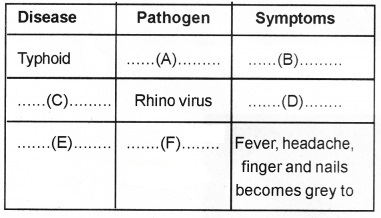
Answer:
- A-Salmonellatyphi
- B – Sustained fever 39-400C
- C – Common cold
- D – Running Nose and Nasal congestion
- E – Pneumonia
- F – Haemophilus influenza
OR
B. Categorise the following organs into two, with appropriate headings. Thymus, Spleen, Bone marrow, Peyer’s Patches(3)
Answer:
- Primary Lymphoid Organs
- Thymus, Bone marrow
- Secondary Lymphoid Organs
- Spleen, Peyer’s Patches
We hope the given Plus Two Zoology Chapter Wise Questions and Answers Chapter 6 Human Health and Disease will help you. If you have any query regarding Plus Two Zoology Chapter Wise Questions and Answers Chapter 6 Human Health and Disease, drop a comment below and we will get back to you at the earliest.
